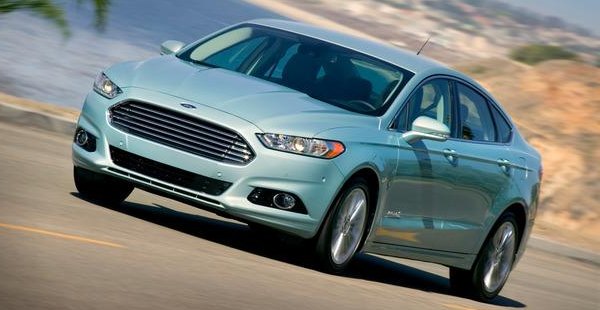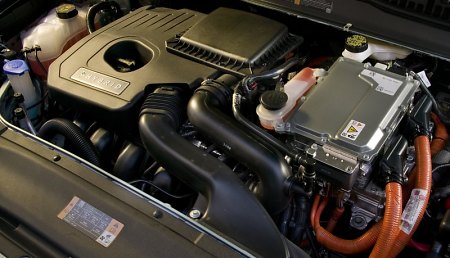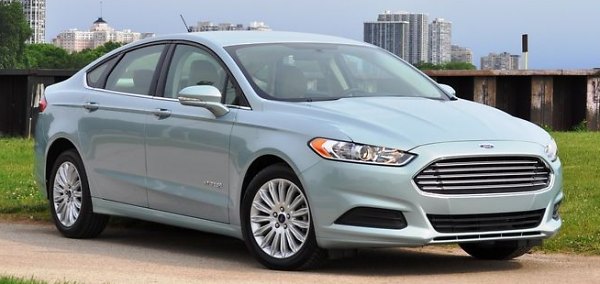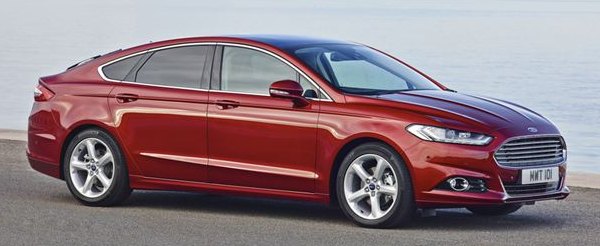|
|
|
Published
on 13
Oct 2012
|
All rights reserved.
|
|
|
Car enthusiasts want
their family cars to look like sports cars and drives like sports cars.
Somehow, car makers give them Camry, Accord and Passat. The only maker
really understands their desire is probably Ford. 6 years ago, we saw a
striking 5-door featuring in James Bond movie, Casino Royale. It got
sports car-like styling and handling, no wonder Mr. Bond agreed to
trade his usual Aston Martin for it. That was the Mk3 Mondeo.
For the past 6 years, the Mondeo remained sitting at the top of our
D-segment family car chart because no one else came close to satisfy
keen drivers quite like it. Even though it starts lagging behind the
competition in terms of green technologies and refinement, it
is still by far our favourite family car as of today. Naturally, we
have very high expectation on the next generation model. It might be
still a year away, but we can already see how good it is from its
American version, Fusion.
Under the "One Ford" strategy, the European Mondeo and the American
Fusion are to be consolidated into a single product, albeit keeping
their existing names for ease of marketing. That is wise, as we used to
doubt the need to develop Fusion while it got the great Mondeo on the
other side of the Atlantic. The new car sits on a new CD-platform but
its genes from the previous Mondeo are obvious. Exterior dimensions are
very close to the old car, in particular the same 2850 mm wheelbase,
thus it is a lot larger than the old Fusion. Owing to a slimmer, longer
nose, it is 88 mm longer overall than the old Mondeo, but it is
slightly narrower and lower. The exterior styling responsible by Chris
Hamilton has evolved to be softer and more streamline, resulting in a
drag coefficient of 0.275. Its highlight must be the Aston Martin-style
nose grille, which contributes to a sportier, classier look than other
mid-size family sedans.
The new chassis gains 10.5 percent in torsional rigidity, thanks to
more extensive use of high-strength steel, laser welding, structural
adhesives and hydroformed tubes (to reinforce roof rails, A and B
pillars). On paper, the suspensions look the same as before –
MacPherson struts up front and multi-links at the rear. However, the
rear ones are actually an all-new design. It switches from the outgoing
Control Blade multi-link to a BMW-style Integral Link design, which
uses a vertical link to tie the upper toe control link and lower
trapezoidal link together, forming a longitudinally rigid geometry so
that it can employ softer bushings to enhance ride comfort. Another
important change is the power steering system, switching from
electrohydraulic to pure electrical assistance, just like most rivals.
Structurally, the interior feels familiar to the old Mondeo. The
driving environment looks much sportier than the class norm due to a
sloping center console, high transmission tunnel and many flashy
decorations. The shallow windows and curvy roof line also contribute to
this sporty feel. On the downside, the cabin looks less roomy than it
actually is. Tape measures found the front seats are the most spacious
in the class, while the two outer rear seats offer about the same
headroom and legroom as the new Honda Accord. It cannot match the
American market Volkswagen Passat though. Despite of the vast wheelbase
– again the longest in class – the rear bench needs to be positioned a
bit forward to compromise with the fastback roof line. That explains
why its rear legroom is only adequate. The new boot, however, is
benefited from a lower floor and becomes the largest in the class.
Tactilely, the interior is just as you would expect for a modern
European car. Dashboard, steering wheel, gear knob, door panels and
grab handles are all made of soft-touch plastics. The driver seat is
supportive and grippy. The Sync multimedia system provides easy
integration with your mobile phone. That said, this cabin still lacks
the classy build quality, attention to details and style of the
European Volkswagen Passat.
However, on the road the Ford displays superior dynamics, once again
leaving all rivals behind. Its chassis feels really rock solid. Very
little wind road noises are allowed to enter the cabin, which makes it
probably the quietest mainstream family car on the market. The
electrical power steering might deliver marginally less feel than the
old one, but it is very precise, naturally weighted and
confidence-inspiring. Besides, a boost in assistance at low speed now
makes parking a lot easier. This is easily the best electrical steering
in its class. The suspension is also worth praising. It keeps the
Mondeo's firm-biased character, resulting in excellent roll and pitch
control as well as quick steering response. However, it also soaks up
bumps and potholes better than the old car, resulting in impressive
refinement. This should satisfy the American buyers now it needs to
cater. Better still, the new suspension does not filter out all the
road information. It just takes the edge off bumps, leaving you to feel
connected to the road. In short, the new car is fun to drive.
For the time being, the base Fusion is offered with a 2.5-liter 175 hp
four-pot engine carried over from the old car. However, I don’t expect
it to soldier for too long. The One Ford strategy drives for the
integration of powertrains worldwide, so the European-developed 1.6
Ecoboost and 2.0 Ecoboost engines (both with direct injection, dual-VVT
and turbocharging) are destined to take the prime time. The smaller
unit produces 178 hp and 184 lbft of torque, sufficient to haul the
slightly heavier car from zero to 60 mph in a decent 8 seconds. The
6-speed manual it partners has slick gearchanges and light clutch,
aiding the small turbo engine to spool up quickly.
Power-hungry American will definitely prefer the gustier 2.0 Ecoboost,
which offers 240 hp and a solid, 270 lbft of mid-range torque. It is
capable of 0-60 mph in about 6.8 seconds. As a credential to
environmental responsibility, the new Ford no longer offers V6 engine.
Considering the good refinement and flexibility of Ecoboost engines,
there is really no need to build V6 just for the limited demand in
America. In Europe, the Mondeo will be additionally offered with a 125
hp 1.0-liter Ecoboost 3-cylinder gasoline and a couple of turbo diesel
engines.
Although it lacks a performance flagship, the new Fusion / Mondeo is
still easily the choice for demanding family car drivers. Ford has
built a global winner.
|
Verdict:      |
| Published
on 13
Oct
2012 |
All rights reserved.
|
|
Fusion Hybrid
|
|

|
The hybrid version returns
with the new Fusion. Not just that, it will be introduced to the global
market for the first time under the Mondeo moniker. Compare with the
outgoing car, it has made a number of changes to improve efficiency and
packaging. The Atkinson-cycle petrol engine has been downsized from 2.5
to 2.0 liters, reducing output by 15 hp to 141 hp. Compensating this is
a more powerful electric motor, now produces 118 hp instead of the
previous 106 hp. Combined output drops 3 hp to 188 hp, but the new car
is slightly lighter and sleeker through the air, so real-world
performance is practically unchanged. We can expect it to take 8.5
seconds to accelerate from 0-60 mph, perfectly acceptable for a green
car.
Thanks to the stronger electric motor, the Fusion Hybrid can travel in
EV mode at up to 62 mph, versus the previous 47 mph or 25 mph on Toyota
Camry Hybrid. This allows the car to run with battery power more of the
time, hence saving fuel. Consequently, the Fusion achieved 47 mpg on
both highway and city in EPA testing, knocking out Camry Hybrid (43/39
mpg) and Hyundai Sonata Hybrid (35/40 mpg) easily!

|
Moreover, the new hybrid system uses lithium-ion battery
instead of the old NiMH battery. Its smaller size allows it to be
fitted under the boot floor and does not hamper luggage space. This is
a strong advantage against its rivals.
On the road, the driving impression is very much the same as the
regular Fusions. Its gasoline engine and electric motor are perfectly
integrated to deliver a smooth, almost undetectable transition. The
Fusion's remarkable insulation means engine noise can be hardly heard
in the cabin. The motor provides ample bottom-end torque so that the
car feels quite brisk around town. The rest of the car is just the same
as other Fusions. The handling and ride are excellent. The steering is
precise and well weighted. Only the brake pedal suffers from an abrupt
transition between regenerative and mechanical braking.
The new Fusion Hybrid is just the first step to overwhelm its Japanese
rivals. Later on we shall see an even more efficient plug-in hybrid
model called Fusion Energi.
|
Verdict:      |
Published
on 8
Aug 2013
|
All rights reserved.
|
|
Fusion Energi
|
|

|
What is Ford Fusion Energi?
In short, it is the plug-in hybrid version of Fusion. Mechanically, the
Energi is practically the same as Fusion Hybrid except that it uses a
larger, 7.6 kWh lithium battery instead of 1.4 kWh unit. This extends
its electric travelling range to 21 miles, which is usable for short
commutes. The 118 hp electric motor provides enough punch to allow
running up to 85 mph, although doing so will drain the battery quickly.
Once the battery is depleted, the car works just the same way as the
Hybrid, using the petrol engine and regenerative braking to recharge
the battery. Of course, you can charge the car at home sockets, which
takes 2.5 hours on 240V supply.
The Energi drives very much like the Hybrid, but its acceleration,
cornering and braking performance are all marginally inferior due to
the 110 kg extra weight contributed by the larger battery. However, the
sounded foundation of Fusion still makes it sportier and more fun to
drive than other green cars, including its direct rival Honda Accord
Plug-in Hybrid. On the downside, the battery eats into the trunk,
reducing luggage space by a third compared with the Hybrid and by half
from the regular Fusion. This could be its biggest drawback. Another
problem is price, which is a whopping 40 percent higher than the
Hybrid. It will be virtually impossible to recoup the extra cost from
fuel saving.
|
Verdict:     |
Published
on 27
Oct 2014
|
All rights reserved.
|
|
Mondeo
|
|

|
Under the "One Ford" policy
Ford merged its American market Fusion and European/Australian/Asian
market Mondeo. It originally wanted to introduce the Mondeo in Europe
shortly after the American debut of Fusion, but that plan was postponed
by the worsening economy in Europe. Consequently, the Mondeo comes 2
years late.
The European car differs from the American version by mainly suspension
setup and choice of engines. Mind you, the changes in the former are
subtle, so it keeps the car's trademark good body control and excellent
composure. European motorists might be a little disappointed by the
electrical power steering's downgrade of communication, but the
Mondeo's nose remains faithful to your input and the whole car still
has the sportiest driver appeal among mainstream family cars.
The European car offers a wide range of diesel engines, including a
couple of 1.6 TDCi and a 2.0 TDCi with 3 states of tune - 150 hp, 180
hp or 210 hp twin-turbo. The latter should be the highlight, but it
won't arrive until early next year. Anyway, the 180 hp version is
strong enough, and it offers superb refinement. On the petrol side, the
new 1.5-liter Ecoboost produces 160 hp and 177 lbft of torque, just
enough to haul the big car without feeling frustrating. The 125 hp 1.0
Ecoboost 3-cylinder sits at the bottom to be the choice for company
cars thanks to tax benefits. Speaking of tax, the outgoing 1.6 Ecoboost
engine is now dead, replaced by the 1.5 Ecoboost as the latter rests on
lower tax band in China. America does not have such tax rules, but the
Fusion has also switched to the 1.5 Ecoboost engine, although it is
tuned to produce 181 hp. One Ford policy is no kidding.
After 2 years, the Fusion/Mondeo is no longer so fresh. Its interior
looks a bit cheap beside the new Volkswagen Passat. However, its cabin
remains remarkably spacious, and its exterior remains the best looking.
|
Verdict:      |
Published
on 2
Sep 2016
|
All rights reserved.
|
|
Fusion V6 Sport
|
|
It might be long time ago,
but we still have fond memories of fast Mondeos, i.e. the first
generation ST200 and the
second generation ST220.
Both offered great driving thrills for little money. Having skipped a
full
generation, Ford finally brings back the performance line. However,
instead of ST, it is called “V6 Sport”. More shocking still, it is
available to the US-market Fusion rather than the
European Mondeo! Why? Because Dearborn believes
European drivers no longer buy sports sedans with non-premium badges,
whereas the
US
still has a healthy following of fast family cars, which is evident
from the V6 models of Accord, Camry, Altima, Maxima etc.
In terms of performance as well as pricing, the Fusion V6 Sport should
be positioned half a notch higher than the aforementioned Japanese V6s.
While the most powerful Accord V6 offers 278 horsepower, Ford
trumps the competition with 325 ponies. In terms of torque it is even
overwhelming – 380 lbft versus 252 lbft. Such a crushing advantage must
thanks to the 2.7-liter Ecoboost twin-turbo V6. This motor actually
comes from the company’s F-150 truck yet it is surprisingly advanced.
It employs direct fuel injection, full
variable valve timing and a pair of turbos which are integrated with
the exhaust manifolds. Unusually, its
cylinder block is made of compacted graphite iron (CGI) like many
premium diesel engines (note: see the 1999 BMW 740d for its first
application), which is stiffer and more capable
to absorb noise and harshness. On the downside, it makes the V6 heavier
than otherwise casted in all-aluminum. Ford said it weighs 200 kg, 28
kg heavier than the V6 turbo on Audi S4. Maybe the Fusion
doesn’t really need the robustness of F-150. Anyway, since Ford is not
going to develop a new engine for the car, it has to accept the
compromise.
The Fusion/Mondeo is already a heavy car. In addition to the heavier
V6, a beefed-up 6-speed automatic transmission, a compulsory AWD
hardware, continuous adaptive dampers and other necessary upgrades, its
kerb weight jumps to more than 1800 kg. That’s why its performance is
not going to challenge Audi S4. 0-60 mph acceleration is estimated to
take 5.5 seconds, a full second adrift of the Audi. Admittedly, the
Audi falls in a different class from the viewpoint of pricing, but a
fully loaded Fusion V6 Sport gets uncomfortably close to BMW 340i,
which is also faster. That’s more worrying.
The rear-drive BMW is also sharper to drive. We love the regular
Fusion’s fine dynamics and ride quality, but it is not as agile as
older generations. With the burden of a 200 kg V6 at its nose, its
turn-in response gets slightly slower again. The wider tires on 19-inch
wheels
provide good roadholding, but the steering is neither quick nor
feelsome enough
to overcome understeer or inspire excitement. The brakes are marginal
to handle the extra heft. The continuous adaptive dampers do help to
achieve remarkable composure while maintaining ride comfort though, so
the great balance between body control and suppleness remains the
greatest asset of the car.
The V6 is pretty good, with quick throttle response and few hints of
turbo lag despite its high specific output. Power delivery is strong
yet smooth. It is not particularly
inspiring to hear, no wonder it needs speakers to play artificial noise
on the press of Sport button. The 6-speed auto gets sportier shift
patterns and rev-match function, but it is still too slow-reacting for
a performance application.
Inside, the cabin is virtually unchanged from lesser Fusions. There is
not even proper bucket seats to hold you tight in corner. Ford argues
that it is not exactly a sports sedan but a very fast and capable
family car. No matter what it said, the fact is this car costs
considerably more than its conventional Japanese V6 rivals to buy and
to fill up its fuel tank. Meanwhile, those demanding more performance
and sharper handling will be better served by BMW 340i if they could
afford a small price premium. Furthermore, the V6 Sport does feel
outdated in a number of areas. It would have fared better if it was
offered from the launch of the current generation Fusion. 4 years on,
the automotive trends have changed a lot. Now we seek lighter weight,
sharper response and higher efficiency (even the Japanese V6s have
lifted efficiency a lot). The big fast Ford suddenly feels
old-fashioned, just like yesterday's V8 dinosaurs. Perhaps it is wise
not to reuse the ST badge.
|
Verdict:    |
|
|
|
|
|
|
|
|
|
|
Fusion
1.6 Ecoboost
|
2012
|
| Front-engined,
FWD |
| Steel monocoque |
| Mainly steel |
| 4872 / 1852 / 1478 mm |
| 2850 mm |
Inline-4
|
| 1596 cc |
DOHC 16 valves, DVVT
|
| Turbo |
| DI |
178 hp
|
184 lbft
|
6-spd manual (6-spd auto)
|
F: strut
R: multi-link
|
| - |
235/45VR18
|
1502 kg
|
| - |
8.0** (8.2*)
|
21.3** (22.9*)
|
|
Fusion 2.0 Ecoboost (AWD)
|
2012
|
Front-engined,
FWD (4WD)
|
| Steel monocoque |
| Mainly steel |
| 4872 / 1852 / 1478 mm |
| 2850 mm |
Inline-4
|
| 1999 cc |
DOHC 16 valves, DVVT
|
| Turbo |
| DI |
240 hp
|
270 lbft
|
6-speed automatic
|
F: strut
R: multi-link
|
| - |
235/45VR18
|
1554 kg
|
| - |
(7.3*)
|
(21.1*)
|
|
Fusion Hybrid
|
2012
|
| Front-engined,
FWD |
| Steel monocoque |
| Mainly steel |
| 4872 / 1852 / 1478 mm |
| 2850 mm |
Inline-4, Atkinson cycle, electric
motor
|
| 1999 cc |
DOHC 16 valves, VVT
|
| - |
| - |
| 141 hp + 118 hp = 188 hp |
129 lbft + 117 lbft
|
| CVT |
F: strut
R: multi-link
|
| - |
225/50R17
|
1668 kg
|
105 mph (limited)
|
9.1*
|
24.9*
|
|
|
|
|
|
Performance
tested by: *C&D, **MT
|
|
|
|
|
|
|
Fusion Energi
|
2013
|
| Front-engined,
FWD |
| Steel monocoque |
| Mainly steel |
| 4872 / 1852 / 1478 mm |
| 2850 mm |
Inline-4, Atkinson cycle, electric
motor
|
| 1999 cc |
DOHC 16 valves, VVT
|
| - |
| - |
| 141 hp + 118 hp = 188 hp |
129 lbft + 117 lbft
|
| CVT |
F: strut
R: multi-link
|
| - |
225/50VR17
|
1775 kg
|
105 mph (limited)
|
8.6*
|
23.0*
|
|
Fusion 1.5 Ecoboost
(Mondeo 1.5 Ecoboost)
|
2014
|
| Front-engined,
FWD |
| Steel monocoque |
| Mainly steel |
| 4872 / 1852 / 1478 mm |
| 2850 mm |
Inline-4
|
| 1499 cc |
DOHC 16 valves, DVVT
|
| Turbo |
| DI |
181 hp (160 hp)
|
185 lbft (177 lbft)
|
6-speed automatic
|
F: strut
R: multi-link
|
| - |
235/45VR18
|
1559 kg (1485 kg)
|
| (138 mph (c)) |
8.2* (8.7 (c))
|
23.1*
|
|
Mondeo 2.0TDCi
|
2014
|
| Front-engined,
FWD |
| Steel monocoque |
| Mainly steel |
| 4871 / 1852 / 1484 mm |
| 2850 mm |
Inline-4 diesel
|
| 1997 cc |
DOHC 16 valves
|
| VTG turbo |
| CDI |
180 hp
|
295 lbft
|
6-speed manual
|
F: strut
R: multi-link
|
Adaptive damping
|
235/45VR18
|
1509 kg
|
140 mph (c)
|
7.8 (c)
|
-
|
|
|
|
|
|
Performance
tested by: *C&D
|
|
|
|
|
|
|
Fusion V6 Sport
|
2016
|
Front-engined,
4WD
|
| Steel monocoque |
| Mainly steel |
| 4872 / 1852 / 1478 mm |
| 2850 mm |
V6, 60-degree
|
| 2694 cc |
DOHC 24 valves, DVVT
|
| Twin-turbo |
| DI |
325 hp / 5500 rpm
|
380 lbft / 3500 rpm
|
6-speed automatic
|
F: strut
R: multi-link
|
Adaptive damping
|
235/40WR19
|
| 1806 kg |
155 mph (est)
|
5.1*
|
13.3*
|
|
|
|
|
|
|
|
Performance
tested by: *C&D
|
|
|
|
|
|
|
|
|
Copyright©
1997-2016
by Mark Wan @ AutoZine
|
|